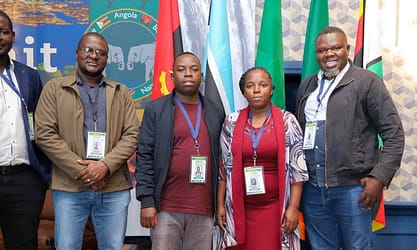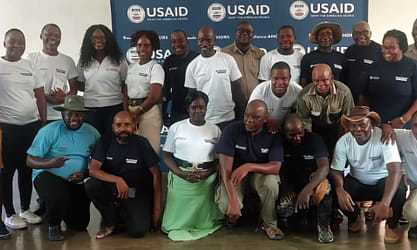
Resource Africa’s position paper affirms the rights of rural communities under the Nagoya Protocol
The Post 2020 Global Biodiversity Framework (GBF) has just been released for comment. By acting now, African countries can work together to ensure that the GBF explicitly includes the sustainable use of wildlife, plants, and the broader ecosystem by indigenous people and local communities. The sustainable use of natural resources is critical to the survival of African rural communities, especially as they are some of the most vulnerable to the impacts of climate change.
To this end, Resource Africa presents its position paper[1] affirming the rights of rural communities within the framework of the UN Convention on Biological Diversity’s (CBD) Nagoya Protocol on Access to Genetic Resources and the Fair and Equitable Sharing of Benefits. The Nagoya Protocol allows communities to benefit from the commercial use and export of their natural resources and/or traditional knowledge. The Nagoya Protocol has already been used successfully to secure the rights of the South African Khoikhoi and San people to derive income from the commercial use of Rooibos, which is used as a tea and herbal medicine in South Africa and exported internationally. If people can claim benefits from a plant that they have used for centuries, why can they not do the same for the animal species they have used for just as long?
Lucrative commercial markets based on African animals include photographic tourism, recreational hunting, live sales and meat. In our globalised world, the clients who are using these resources are not necessarily African (especially in the high-value markets of tourism and hunting), but neither are Rooibos consumers. The use of wildlife relies on traditional knowledge as much as the use of the biological resource Rooibos. The art of tracking animals (used in both tourism industries) is a large part of San, Khoikhoi and Shangaan cultures, to name a few. Traditional ways of skinning and preparing game meat are still used today, while many tourist lodges and camps use African culture and art for decorative purposes.
All of the above forms of utilisation constitute the use of the whole of the biological and/or genetic resources and traditional knowledge of indigenous and local communities, thus satisfying the requirements for formal Access and Benefit Sharing (ABS) arrangements to be established under the Nagoya Protocol (read more about this here[2]).
This is a key opportunity for African governments to work within the framework of the UN CBD to provide tangible benefits for their people that will incentivise biological conservation. For example, people living near protected areas could become real shareholders in the conservation and use of the wildlife occurring there. On community lands, this arrangement could pave the way for more engagement with the wildlife economy by strengthening the rights that local communities have over their resources.
This approach resonates with southern African countries that have established their own community-based natural resource management (CBNRM) programmes, whereby local communities manage their wildlife and benefit from its use. Using the Nagoya Protocol, these rights would put rural communities in a stronger position when negotiating contracts with private sector partners in the tourism and hunting industries. Although these Access and Benefit Sharing Agreements would necessarily take a different form to the Rooibos case (which involved a traditional knowledge levy), the basic principle that local communities have the right to benefit from the commercial use of their resources. In countries where CBNRM has not yet been developed, this approach could open the door for communities that want to regain control over and benefits from over their resources.
Besides the UN CBD, other key Multilateral Environmental Agreements and/or decisions explicitly mention the legal principle of sustainable use of natural resources (discussed in detail here[3]). The Convention of International Trade in Endangered Flora and Fauna (CITES) was originally set up to facilitate cross-border trade. However, CITES trade decisions are becoming increasingly restrictive, while many national and international laws consider plants and animals separately. Animal rights movements continue to pressure governments to tighten controls on how animals are used. Consequently, despite the well-established legal principle of sustainable use, people living in rural areas are still cut off from using their resources, especially animals.
These issues create conflicts between the needs of rural Africans and current legal systems, some of which end in tragedy. People using resources in protected areas are pitted against those protecting these areas in a never-ending “war on poaching”, with tragic losses of life on both sides. This leads African people to question the validity of wildlife conservation generally, which is unfortunate given their strong cultural traditions that should actually enhance the conservation of biodiversity. The system as it stands is broken, but we can fix it.
In this Super Biodiversity year, it is critical that we finally start fixing the system by focusing on social and environmental justice. One way of doing this is by linking the Nagoya Protocol to CBNRM policies in Africa that recognise sustainable use of wildlife as a right that generates benefits for local communities. Alongside the launch of the position paper, we are hosting a webinar on the 26th of August 2021 at 16:00.
The keynote speaker, Ms. Kauna Schröder, is the chairperson of the international compliance committee for the Nagoya Protocol and the Namibian focal point for the Nagoya Protocol. Ms. Schröder will join Prof. Ademola Oluborode Jegede who drafted the Resource Africa position paper, and representatives of indigenous and local communities in South Africa, Namibia and Malawi to discuss the implications of this approach to the sustainable use of wildlife.
[1] Link to PDF of policy brief


